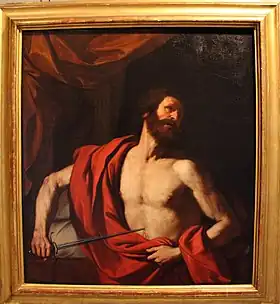The Suicide of Cato
The Suicide of Cato is a 1641 oil on canvas painting, now in the Palazzo Rosso in Genoa.[1]

History
Showing Cato the Younger, it was commissioned by Marcantonio Eugenio, a lawyer from Perugia active in Rome.[1] A note in the painter's payment book refers to a sum equivalent to 15 scudi paid to him for the work on 22 November 1640, with the balance settled on 7 December 1641 with 45 scudi.[2] It was a pendant to a now lost Death of Seneca, also valued at 60 scudi and also received by Eugenio in 1643 - that subject was popular in Guercino's oeuvre and he produced another version for cardinal Antonio Barberini for 75 scudi.[1] The Suicide of Cato appeared in 18th century inventories of the Brignole collection until being donated to the city by Maria Brignole Sale, the last surviving member of that family.[1]
References
- (in Italian) P. Bagni, D. De Grazia, D. Mahon, F. Gozzi and A. Emiliani, Giovanni Francesco Barbieri Il Guercino 1591-1666, a cura di Denis Mahon, Bologna, Nuova Alfa Editoriale, 1991, ISBN 9788877792846, p. 240.
- (in Italian) P. Boccardo, La Galleria di Palazzo Rosso Genova, Milano, Federico Garolla Editore, 1992, pp. 47-51.